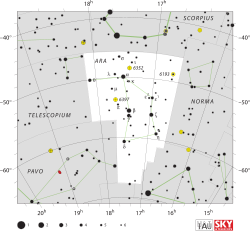Eta Arae
| Observation data Epoch J2000 Equinox J2000 | |
|---|---|
| Constellation | Ara |
| Right ascension | 16h 49m 47.15653s[1] |
| Declination | –59° 02′ 28.9575″[1] |
| Apparent magnitude (V) | 3.76[2] |
| Characteristics | |
| Spectral type | K5 III[3] |
| U−B color index | +1.93[2] |
| B−V color index | +1.57[2] |
| Astrometry | |
| Radial velocity (Rv) | +9.0[4] km/s |
| Proper motion (μ) | RA: +39.73[1] mas/yr Dec.: –24.91[1] mas/yr |
| Parallax (π) | 10.90 ± 0.20 mas[1] |
| Distance | 299 ± 5 ly (92 ± 2 pc) |
| Absolute magnitude (MV) | –1.14 ± 0.14[5] |
| Details | |
| Mass | 1.02 ± 0.12[5] M☉ |
| Radius | 55.9 ± 7.3[5] R☉ |
| Surface gravity (log g) | 0.92 ± 0.12[5] cgs |
| Temperature | 3,886[5] K |
| Metallicity [Fe/H] | –0.37[5] dex |
| Age | 7.11 ± 2.34[5] Gyr |
| Other designations | |
Eta Arae (η Ara, η Arae) is the Bayer designation for a single [7] star in the southern constellation of Ara. It is approximately 299 light-years (92 parsecs) from Earth and is visible to the naked eye with an apparent visual magnitude of 3.76.[2]
The spectrum of this star matches a stellar classification of K5 III,[3] indicating that, at an estimated age of seven billion years,[5] it has reached the giant star stage of its evolution. With a mass nearly the same as the Sun, it has an outer envelope that has expanded to nearly 56 times the Sun's radius.[5] The star is now spinning so slowly that it takes more than eleven years to complete a single rotation.[8] Eta Arae is radiating energy into space at an effective temperature of 3,886 K,[5] giving it the orange-hued glow of a K-type star.[9]
It has a 14th magnitude optical companion, located 25.7 arcseconds away.
References
- ^ a b c d e van Leeuwen, F. (November 2007), "Validation of the new Hipparcos reduction", Astronomy and Astrophysics, 474 (2): 653–664, arXiv:0708.1752, Bibcode:2007A&A...474..653V, doi:10.1051/0004-6361:20078357.
- ^ a b c d Johnson, H. L.; et al. (1966), "UBVRIJKL photometry of the bright stars", Communications of the Lunar and Planetary Laboratory, 4 (99), Bibcode:1966CoLPL...4...99J.
- ^ a b Houk, Nancy (1978), Michigan catalogue of two-dimensional spectral types for the HD stars, vol. 1, Ann Arbor: Dept. of Astronomy, University of Michigan, Bibcode:1975mcts.book.....H.
- ^ Wilson, Ralph Elmer (1953), General catalogue of stellar radial velocities, Carnegie Institution of Washington, Bibcode:1953GCRV..C......0W.
- ^ a b c d e f g h i j da Silva, L.; et al. (November 2006), "Basic physical parameters of a selected sample of evolved stars", Astronomy and Astrophysics, 458 (2): 609–623, arXiv:astro-ph/0608160, Bibcode:2006A&A...458..609D, doi:10.1051/0004-6361:20065105.
- ^ "eta Ara -- Star in double system", SIMBAD Astronomical Database, Centre de Données astronomiques de Strasbourg, retrieved 2012-07-27.
- ^ Eggleton, P. P.; Tokovinin, A. A. (September 2008), "A catalogue of multiplicity among bright stellar systems", Monthly Notices of the Royal Astronomical Society, 389 (2): 869–879, arXiv:0806.2878, Bibcode:2008MNRAS.389..869E, doi:10.1111/j.1365-2966.2008.13596.x.
{{citation}}: CS1 maint: unflagged free DOI (link) - ^ Setiawan, J.; et al. (July 2004), "Precise radial velocity measurements of G and K giants. Multiple systems and variability trend along the Red Giant Branch", Astronomy and Astrophysics, 421: 241–254, Bibcode:2004A&A...421..241S, doi:10.1051/0004-6361:20041042-1.
- ^ "The Colour of Stars", Australia Telescope, Outreach and Education, Commonwealth Scientific and Industrial Research Organisation, December 21, 2004, retrieved 2012-06-24.

